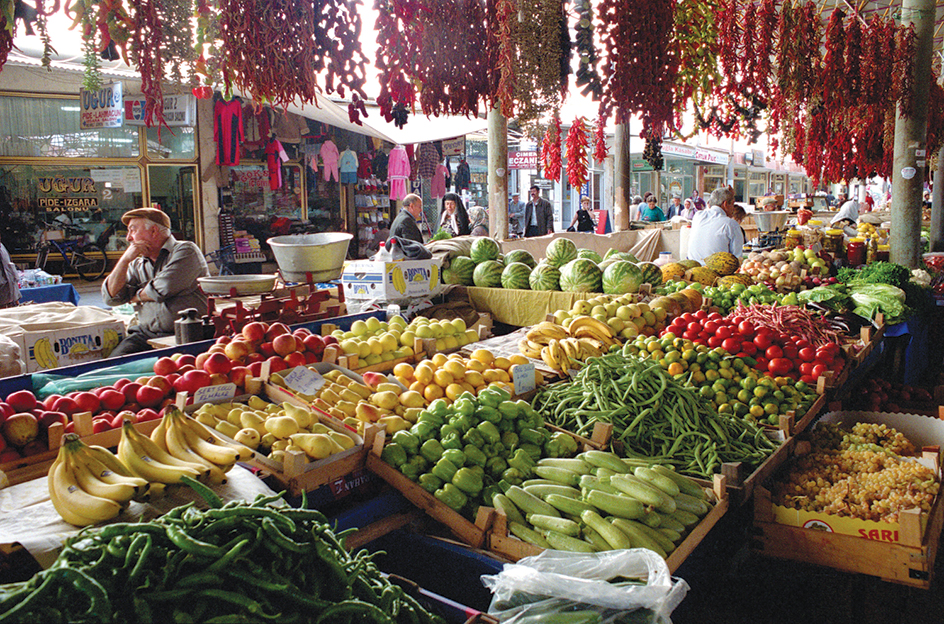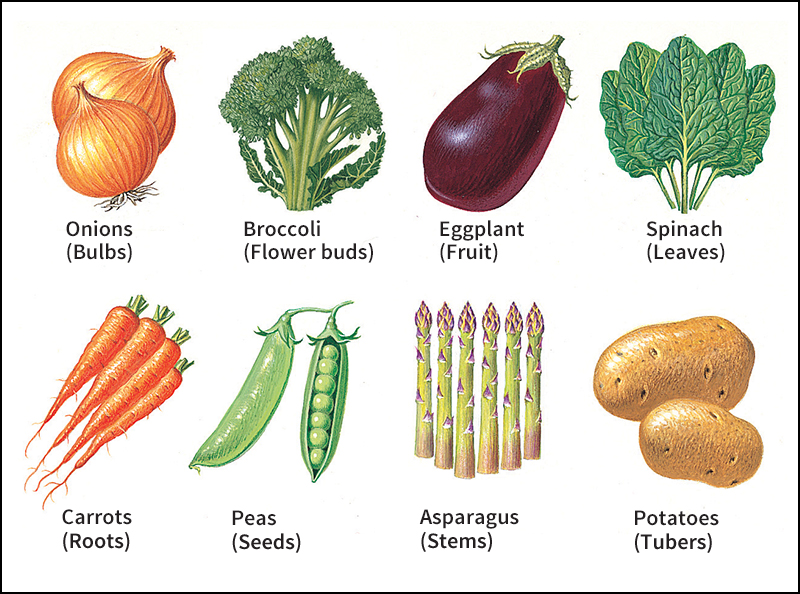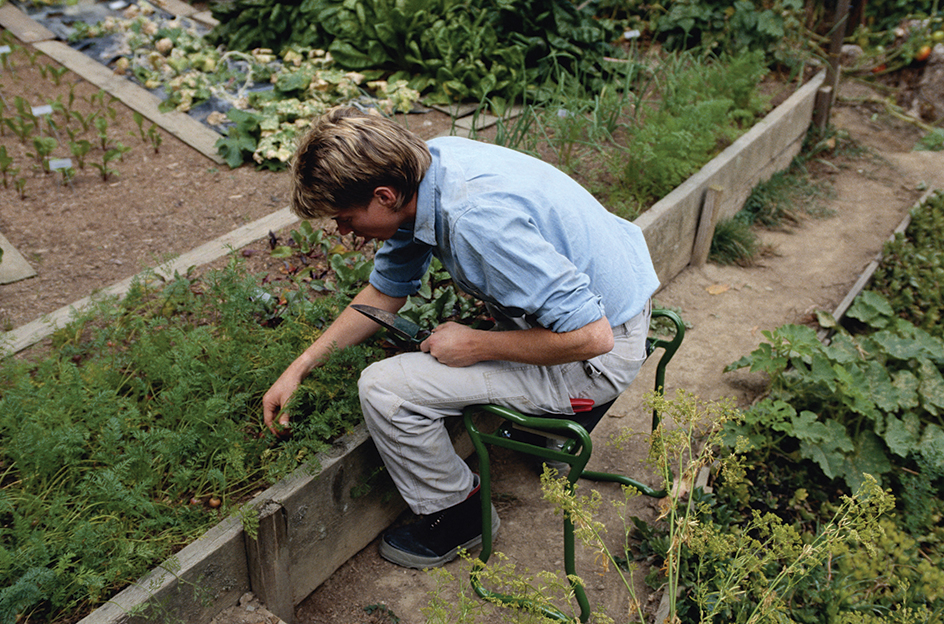Vegetable commonly refers to an edible part of a non-woody plant. Such edible parts include leaves, roots, seeds, stems, or even fruits. Vegetables rank among the most healthful of all foods. They contain many key nutrients (nourishing substances). People eat raw or cooked vegetables as a dish in a main meal, as part of a salad or soup, or as a snack. Vegetable growing forms a major branch of horticulture, a field of study that also includes fruit production, flower production, and landscaping.

Most vegetables come from plants called annuals, which live for one growing season. They include musk-melons, watermelons, and other foods commonly thought of as fruits. Such vegetables as carrots and onions come from biennials, plants that require two growing seasons to produce seed. Asparagus, Jerusalem artichokes, and a few other vegetables grow as perennials. These plants live for more than two growing seasons.
Vegetables form a vital part of the human diet. They provide good sources of vitamins A, B, and C and such minerals as iron, and potassium. Vegetables also yield fiber, which helps people digest food properly. In addition, vegetables contain compounds called phytonutrients, many of which may help prevent certain cancers.
People eat vegetables fresh or processed. Leading vegetables sold fresh to consumers include potatoes, the most widely grown vegetable, as well as lettuce and carrots. Food processing companies handle more tomatoes than any other vegetable. Processed tomatoes occur in cans—both whole or diced—as well as in tomato paste, ketchup, and salsas. Pureed tomatoes are cooked until soft and then processed in a blender or pushed through a strainer or sieve. Major processed frozen vegetables include broccoli, peas, and sweet corn.
China ranks as the leading producer of several major vegetable crops. Other key vegetable-growing countries include India, Nigeria, and the United States.
This article deals primarily with the commercial production of vegetables. For information on home vegetable growing, see Gardening.
Kinds of vegetables
Vegetables are often grouped according to the part of the plant from which they come. Plant parts used as vegetables include bulbs, flower buds, fruits, leaves, roots, seeds, stems, and tubers.

Bulbs
are underground organs consisting of several layers of fleshy leaves that surround a short or flattened stem. Bulb crops include garlic, onions, and shallots.
Flower buds.
Broccoli ranks as the most common flower bud used as a vegetable. It has a head composed of densely packed flower buds on a thick, fleshy flower stalk. Globe artichokes, another flower bud vegetable, consist of edible bases and leafy scales.
Fruits
are ripened ovaries—that is, the parts of flowering plants that contain the seeds. Vegetables from fruits include eggplants, muskmelons, okra, peppers, pumpkins, snap beans, snap peas, squash, and tomatoes.
Leaves
eaten as vegetables include Brussels sprouts, cabbage, kale, lettuce, and spinach. In two leaf vegetables, celery and rhubarb, petioles (leaf stalks) make up the edible parts instead of the leaf blades.
Roots
form vegetables in such plants as beets, carrots, parsnips, radishes, and turnips. Most root vegetables occur as enlarged main roots called taproots. Sweet potatoes develop from enlarged fibrous roots on stem cuttings used to propagate (reproduce) the plants.
Seeds.
Horticulturists usually classify seeds eaten in immature form as vegetables. Cowpeas, kidney beans, and sweet corn rank among the major seed vegetables.
Stems
support the branches, leaves, and fruits of plants. For one stem vegetable, kohlrabi, people eat only the main stem’s swollen base. For another type, asparagus, people eat both the stem and the young shoot.
Tubers
grow from stolons (specialized underground stems) that develop into enlarged, fleshy organs. Tuber vegetables include potatoes and Jerusalem artichokes.
Growing vegetables
Growers use the term vegetable culture to describe the various practices for growing vegetables. Vegetable culture involves four primary steps: (1) field preparation, (2) planting, (3) irrigation, and (4) pest control.

Field preparation.
Growers initially prepare fields for planting by turning over deep layers of soil with a plow. They then spread chemical fertilizer or manure on the land to provide nutrients for the coming crop. They mix the fertilizer into the soil and break up large soil particles to form a flat, uniform seed bed. Some growers create raised beds to provide better drainage and help warm the soil.
Planting.
Growers plant vegetables in rows, either by direct seeding or by transplanting. In direct seeding, specialized machines called seeders make a small furrow in the soil, drop the seeds in the furrow, cover the seeds, and press the soil firmly over them. Seeds may be coated with coloring and protective chemicals or pelleted with clay or other materials to make them more uniform and easier to plant. Some seeders deposit bands of additional fertilizer beside the seeds.
In transplanting, growers cultivate vegetables from small seedlings called transplants. They grow transplants on flats (small trays) in temperature-controlled greenhouses. Workers plant the seeds in the flats either by hand or by specialized machines. They then place the flats on greenhouse benches and moisten them to germinate the seeds and grow the seedlings. Once the seedlings reach an acceptable size, farmers transport them to the field for hand or machine transplanting. Many transplanting machines also inject water or fertilizer into the transplant holes to help the plants grow.
Irrigation.
Most vegetables need extra irrigation to maintain strong, uniform growth. There are three major types of irrigation: (1) furrow irrigation, (2) sprinkler irrigation, and (3) drip irrigation.
In furrow irrigation, workers make deep furrows between the rows of the planted crop. Tubes divert water from irrigation canals to the crop through these furrows.
In sprinkler irrigation, wide pipes transport water from a pond or well to sprinklers in the field. This system enables farmers to deliver water evenly to crops.
In drip irrigation, hoses move water from wells or other sources to plastic pipes and tubes that run above the surface of the field. Small, regularly spaced holes in the tubing enable water to drop slowly onto the planted rows. Farmers prefer drip irrigation to other methods because it delivers water directly to the plants and conserves the water supply.
Pest control.
Harmful crop pests include weeds, insects, and diseases. Weeds reduce crop yields by competing with them for nutrients, water, and sunlight. Several weed-controlling methods exist. Many farmers spray the soil with selective herbicides, chemicals that kill weeds but not crops. For such warm-season vegetables as tomatoes and cucumbers, farmers cultivate the plants on beds covered with thin, porous sheets of black plastic. This practice not only helps control the weeds, which grow only in uncovered parts, but also conserves water and nutrients.
Various insects consume the leaves or juices of vegetable plants, thus reducing crop yields and often damaging the edible portions of crops. Other insects called vectors transfer diseases to plants that affect the leaves, roots, or fruits. Bacteria, fungi, or viruses also may spread such diseases. Many growers kill pests by spraying pesticide chemicals on crops. Yet overuse of pesticides can damage the environment, and farmers must use caution to avoid possible pesticide residues on food crops. To avoid these potential problems, many farmers now control pests by using pest-resistant vegetable varieties. Scientists have created many such varieties by altering the plants’ genes (units of heredity).
Some farmers combat crop damage by using a practice known as organic farming. Organic farmers usually avoid chemical fertilizers and genetically engineered vegetable varieties. Instead, they employ natural soil- improving techniques to minimize the harmful effects of weeds, insects, and diseases.
Harvesting and marketing vegetables
Farmers must harvest vegetables at the correct stage of maturity. In many cases, they immediately cool the harvested crop to prevent loss of water and wilting. Some vegetables, such as tomatoes and melons, will not achieve acceptable eating quality if picked when they are immature. If picked when overripe, most vegetables will lose eating quality or spoil during shipment.
Growers with small plots often market their vegetables locally at a farm stand or farmers’ market. They harvest ripe crops so that the vegetables will be ready for consumption when they reach the local markets.
Growers with large farms usually sell their vegetables to brokers or distribution companies. They typically harvest crops at a slightly immature stage to allow for longer-term storage and shipping. Such growers must grade fresh-market vegetables for size and quality, trim the outer leaves, and sometimes cool and wash the produce before packing. For some crops, farmers may grade and pack the vegetables in the field using machines. For crops that need washing or special sorting, grading, or cooling, growers use large packing sheds.
Distribution companies typically ship vegetables by refrigerated trucks, railroad cars, and planes to regional warehouses. There, they store the produce at cool temperatures for a brief period before shipping them to various markets.
